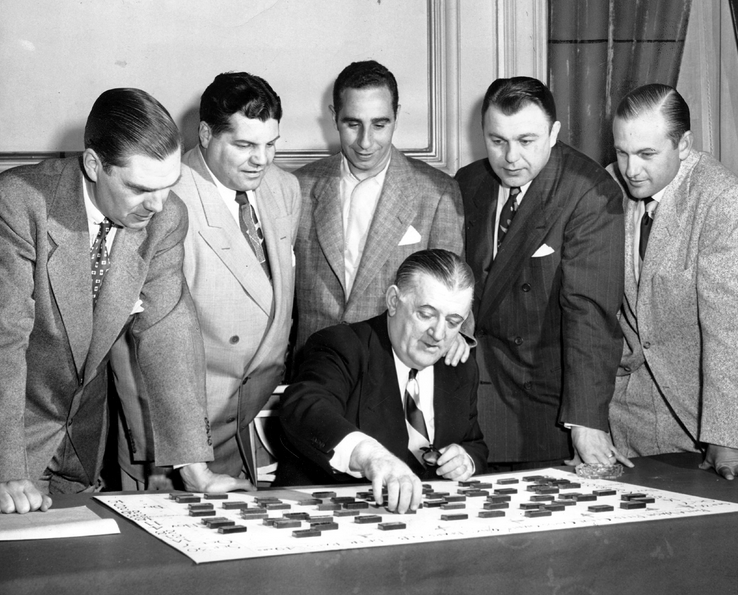Sometime soon the NFL is expected to do something about the extra point. What that something is will be decided by the Competition Committee, the owners and possibly the ASPCK (American Society for the Prevention of Cruelty to Kickers). It’s beginning to bother me, though, that I haven’t heard Two Little Words very much, words that should be a big part of this discussion:
Point value.
By point value, I’m talking mainly about the relationship between the touchdown (six points) and the field goal (three). Since the league was founded in 1920, a TD has almost always been worth more than two field goals because the PAT has been virtually automatic. This, to my mind, is as it should be. Driving the length of the field and punching the ball across is more of an accomplishment than, say, getting stopped twice at the 30 and booting a pair of 48-yard field goals.
That’s especially true nowadays, when a field-goal try has about the same success rate as a Stephen Curry free throw. Last season kickers made 84 percent of their three-pointers (61 percent from 50 yards and beyond). The year before they were even more accurate (86.5).
One of the arguments for dickering with the PAT is to reduce the impact of these specialists, which is far out of proportion to the time they spend on the field. So why, I ask, would you want to change the rule so that there would be more unsuccessful point-afters, as the league is reportedly considering? Because if there are more of those — by either run, pass or kick — then you have more instances of a touchdown being worth only six points . . . the same as two field goals.
I’d rather have a TD worth seven points — as it’s essentially been for decades — and give the scoring team a chance for a bonus point from the 2-yard line – or wherever the odds would be closest to 50/50. No kicks allowed. (There are more than enough of those.)
Then you’d have an Exciting Play after every touchdown and games would sometimes decided by the proficiency of a team’s extra-point offense (or defense). Wouldn’t that be preferable to what we have now? If you wanted to add some spice to it, you could give the D the opportunity to score a point by returning a fumble or interception the length of the field (something the league is also said to be weighing). Seems only fair.
This, of course, would involve burying the two-point conversion. Let’s face it, there’s always been a certain illogic to it. For moving the ball two yards, the offense scores as many points as the defense does for tackling the ball carrier in the end zone for a safety — and almost as many as a kicker does for booting a 64-yard field goal. Again, it all goes back to point value.
Pro football doesn’t the need a gimmick like that. Scoring is at historic levels; in each of the last three seasons it’s topped 45 points a game, equaling the previous best three-year stretch from 1948 to ’50. The Patriots-Seahawks Super Bowl, meanwhile, drew 114.4 million viewers, a record for the game. The NFL’s customers are clearly satisfied, whether the PAT is reimagined or not.
It would do the league no harm, that I can see, to leave the point-after exactly as is. (Would it make one dollar less?) But it could do it some harm if four or five goal-line plays were added to each game. All we’d need is a star player or two to suffer a season-ending injury — for the sake of a measly additional point — and we’d have sports-talk-show hosts shrieking, “What the #%&@! were they thinking?”
(Note: The short-lived World Football League adopted, in 1974, a rule like the one I’m proposing. After a touchdown, which was worth seven points, the ball was marked at the 2 ½-yard line, and the scoring team could add another point via a run or pass. The “action point,” it was called.)
There are reasons the extra point has, over the decades, fought off attempt after attempt to eliminate it. Its history, in fact, is infinitely more interesting than the play itself. The play itself is a metronomic bore: snap, hold, kick. (Or as I like to think of it: We interrupt this game to bring you the World Cup.) It also has never seemed like much of a football play, even if it does involve the foot.
Worse, it’s utterly predictable. Only once in the last nine seasons, near as I can determine, has a game been decided by a missed PAT — this one between the Cardinals and Cowboys on Dec. 25, 2010. (Merry Christmas!)
At least as early as 1933, there were folks in the NFL lobbying to get rid of the point-after. That was the year the Giants’ Tim Mara sought to “abolish” it and replace it with “a 10-minute overtime period in the event that the regulation game ends in a tie,” The New York Times reported.
Mara pointed out that of 58 league games played during the past season only one was decided by the extra point and that [10] . . . resulted in ties.
“In every sport but football authorities have sought to avoid a tie score,” Mara declared. “No matter whom you are rooting for you don’t want to see a game end in a tie. The game has reached such a stage now that few field goals are attempted. The one desire seems to be a touchdown.”
So that, maybe, was the first grenade lobbed in the PAT’s direction. The league was choking on tie games, and the point-after wasn’t helping to break those ties (which is one of the things it was supposed to do).
Bert Bell, as owner of the Eagles and later as NFL commissioner, made the quashing of the extra point a personal crusade. He did everything he could to get it stricken from the rulebook. One of his main arguments was that the change would “do away with the one-point spread in which gamblers are so much interested,” he said in 1951. This, he predicted, would cut down “gambling by 60 percent.”
Not long afterward he pushed for touchdowns to be revalued at seven points — thereby making the PAT superfluous. The Times referred to it as his “perennial suggestion.” It was voted down, 7-5.
Lloyd Larsen, the Milwaukee Sentinel columnist, joked that Bell might have had an ulterior motive. “Could it be,” he wondered, “that his real concern is the cost of footballs [$17 per] kicked into the crowd?”
Actually, there might have been some truth to this — in the early years, anyway. One Sunday in 1935, Bell nearly ran out of footballs during a blowout loss to the Bears in Philadelphia. Chicago’s Jack Manders kept booting extra points into the stands, and the fans kept keeping them as consolation prizes. By the third quarter, only one usable ball was left. So after their last two touchdowns, the Bears waived their right to a PAT and just lined up for the kickoff. That explained the unusual final score: 39-0.
In 1968, almost a decade after Bell’s death, the NFL and AFL conducted a joint experiment with the point-after. In the 23 interleague preseason games that year — this was before the merger, remember — teams were given the option of running or passing for the point from the 2-yard line. Kicks were verboten.
But while the provisional rule jazzed up some otherwise dreary exhibition games, it never gained much traction with the owners — and was deposited, along with all the other brainstorms whose time had not yet come, in the dustbin of history.
And now here we are, almost half a century later, wrestling with the PAT question again. I just wish, while we were mulling the issue, the words “point value” were being thrown around more often. Two field goals should never equal a touchdown. They just shouldn’t.
Source: pro-football-reference.com


